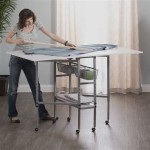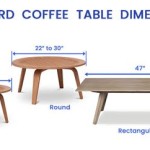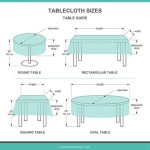How Many Can Be Seated At A 60-Inch Round Table?
Determining the optimal seating capacity for a 60-inch round table is a common consideration for event planners, caterers, and individuals hosting gatherings. The answer is not a fixed number, however, as it depends on several factors, including the desired level of comfort, the type of event, the width of the chairs being used, and the overall ambiance one wishes to create. A careful evaluation of these aspects is necessary to ensure that guests have a pleasant and comfortable experience.
A 60-inch round table, also known as a 5-foot round table, provides a sizeable surface area, making it a versatile option for various events, from formal dinners to casual buffets. Understanding the different seating arrangements and their implications on guest comfort and movement is crucial for maximizing the utility of the table and ensuring a successful event.
Assessing Comfortable Seating Capacity
The primary factor in determining seating capacity is individual comfort. Cramped seating arrangements can lead to discomfort, restricted movement, and a negative overall experience. While it might be tempting to maximize the number of guests around a table, prioritizing comfort is generally considered a wiser approach. A general guideline suggests allocating approximately 24-30 inches of table space per person. This allows for adequate elbow room and prevents guests from feeling crowded.
Using this guideline, one can calculate the approximate circumference of a 60-inch round table using the formula C = πd, where C is the circumference, π is approximately 3.14159, and d is the diameter (60 inches). This yields a circumference of roughly 188.5 inches. Applying the 24-30 inch per person guideline, this suggests a seating capacity of approximately 6 to 8 individuals. This calculation, however, provides a theoretical maximum. Additional considerations, such as chair size and table setting complexity, play a significant role in the practical application of this estimate.
For events prioritizing ample personal space and a more relaxed atmosphere, opting for the lower end of the range (6 people) would be advisable. This allows for more comfortable interaction and prevents guests from feeling restricted. Conversely, for events where space is limited or a more communal atmosphere is desired, seating 8 people might be acceptable, provided the chair width and table settings are carefully considered.
The Influence of Chair Size and Style
The dimensions of the chairs used significantly impact the number of people who can be comfortably seated at a 60-inch round table. Wide chairs, particularly those with arms, require more space and can reduce the available seating capacity. Conversely, narrower chairs, such as those commonly used in banquets or formal settings, allow for more efficient utilization of the table's circumference.
Before finalizing the seating arrangement, it is imperative to measure the width of the chairs that will be used. This measurement should include the widest point of the chair, including any armrests. If the chairs are particularly wide, it may be necessary to reduce the number of guests per table to ensure adequate spacing and prevent discomfort. For instance, using chairs that are 24 inches wide or more might necessitate reducing the seating capacity to 6 individuals to maintain a comfortable environment.
The style of the chair also contributes to the overall comfort and perceived space available. Chairs with high backs can create a sense of enclosure and potentially make the table feel more crowded. Conversely, chairs with low backs or those without arms can contribute to a more open and spacious feeling, allowing for a slightly higher seating capacity without compromising comfort. The aesthetic impact of the chairs shouldn't be neglected either. The chairs should complement the table and the overall event decor, contributing to a cohesive and visually appealing setting.
Impact of Table Settings and Event Type
The complexity of the table settings influences the usable surface area and, consequently, the seating capacity. Elaborate table settings with multiple courses, extensive silverware, and decorative centerpieces demand more space per person. A simple buffet-style setup with minimal tableware allows for a more efficient use of the table's surface and potentially accommodates a slightly larger number of guests.
Furthermore, the type of event dictates the level of formality and the desired level of comfort. For formal dinners and banquets, a more spacious seating arrangement is typically preferred, allocating ample space for each guest and ensuring a comfortable dining experience. This might translate to seating only 6 or 7 individuals at a 60-inch round table. For more casual events, such as cocktail parties or informal gatherings, a slightly more compact seating arrangement might be acceptable, potentially accommodating 8 people.
The age and mobility of the guests should also be factored into the decision-making process. Elderly guests or those with mobility limitations require more space for comfortable seating and maneuvering. Adjusting the seating arrangement to accommodate these needs can significantly enhance the overall experience for all attendees. Thoughtful planning ensures that all guests, regardless of their physical abilities, can comfortably participate in the event.
The presence of centerpieces should also be considered. Large, elaborate centerpieces can significantly reduce the usable surface area of the table, making it feel more crowded. Choosing smaller, more streamlined centerpieces or opting for alternative decorative elements, such as overhead lighting or wall decorations, can help maximize the available space and maintain a comfortable seating arrangement.
In conclusion, the appropriate seating capacity for a 60-inch round table is a multifaceted issue that demands careful consideration of various factors. While the circumference of the table and the 24-30 inch per person guideline provide a starting point, the chair size and style, the complexity of the table settings, and the nature of the event all play a crucial role in determining the optimal number of guests. Prioritizing guest comfort and creating a visually appealing and functional space are essential for a successful and enjoyable event.

60 Round Table Seat 8 To 10 Destination Events

60 Round Table Seat 8 To 10 Destination Events

Round Table Seating Guide Diy Kitchen Dining Room

Amish Table Size Guide What Dining Do You Need

Table Seating Capacity Contemporary Craftsman Furniture

Dining Room Seating Basics Gmi Design Group

72 Round Plywood Banquet Table The Chiavari Chair Company

Tent Ing Information For 20 By Party Tents

60 Inch Round Table 49 Off Showmaster Nl

Professional Table Seating Guide The Chiavari Chair Company Is Now Chivari








